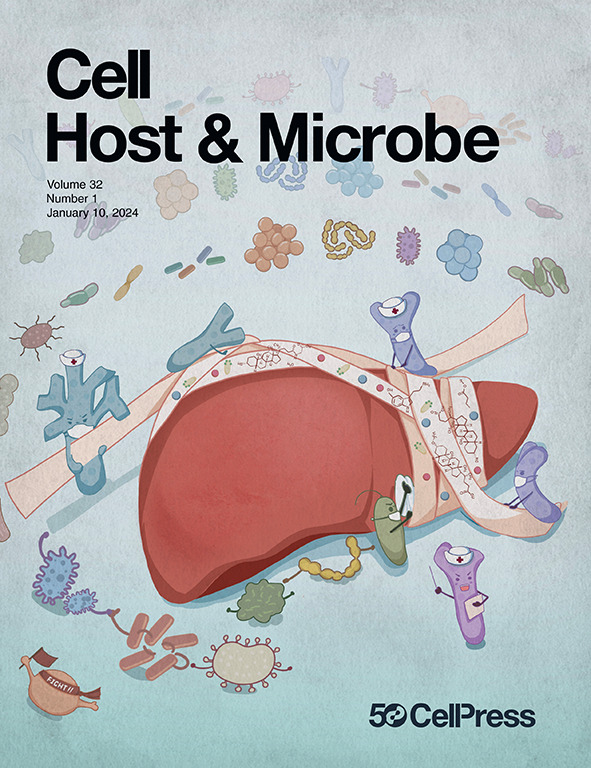鞘脂类拟杆菌通过甲羟戊酸途径促进抗炎反应
IF 18.7
1区 医学
Q1 MICROBIOLOGY
引用次数: 0
摘要
源自拟杆菌的鞘脂与宿主炎症和代谢综合征的变化有关;然而,宿主细胞内的信号传导机制尚不清楚。我们利用野生型和鞘脂缺乏拟杆菌菌株的外膜囊泡(omv)来了解这些脂质如何调节宿主炎症。研究结果表明,双氢神经酰胺磷酸乙醇胺(CerPE)富集。omv将细菌鞘脂传递到宿主树突细胞和上皮细胞中,其中包括CerPE在内的一类脂质稳定存在。同样,B. thetaiotaommicron定植导致鞘脂在小鼠组织中的持久性和宿主脂组的改变,而在鞘脂缺乏菌株中没有观察到这一点。omv在树突状细胞中诱导有效的鞘脂依赖性白介素-10 (IL-10)抗炎反应,这依赖于甲羟戊酸途径的激活。在鞘脂缺乏的omv中加入CerPE片段可以挽救IL-10的分泌,同样依赖于甲羟戊酸途径的激活。这些数据强调鞘脂在刺激甲羟戊酸途径诱导介导的抗炎反应中的重要作用。本文章由计算机程序翻译,如有差异,请以英文原文为准。

Bacteroides sphingolipids promote anti-inflammatory responses through the mevalonate pathway
Sphingolipids derived from Bacteroides species are associated with changes in host inflammation and metabolic syndrome; however, the signaling mechanisms within host cells are unknown. We utilize outer membrane vesicles (OMVs) from wild-type and sphingolipid-deficient Bacteroides strains to understand how these lipids modulate host inflammation. Characterization of the lipidome of B. thetaiotaomicron OMVs revealed enrichment of dihydroceramide phosphoethanolamine (CerPE). OMVs deliver bacterial sphingolipids into host dendritic and epithelial cells, where a subset of lipids, including CerPE, stably persist. Similarly, B. thetaiotaomicron colonization results in sphingolipid persistence in murine tissues and host lipidome alterations that are not observed with the sphingolipid-deficient strain. OMVs induce a potent, sphingolipid-dependent interleukin-10 (IL-10) anti-inflammatory response in dendritic cells, which depends on mevalonate pathway activation. Adding a CerPE fraction to sphingolipid-deficient OMVs rescued IL-10 secretion, similarly dependent on mevalonate pathway activation. These data highlight the essential roles of sphingolipids in stimulating anti-inflammatory responses mediated by mevalonate pathway induction.
求助全文
通过发布文献求助,成功后即可免费获取论文全文。
去求助
来源期刊

Cell host & microbe
生物-微生物学
CiteScore
45.10
自引率
1.70%
发文量
201
审稿时长
4-8 weeks
期刊介绍:
Cell Host & Microbe is a scientific journal that was launched in March 2007. The journal aims to provide a platform for scientists to exchange ideas and concepts related to the study of microbes and their interaction with host organisms at a molecular, cellular, and immune level. It publishes novel findings on a wide range of microorganisms including bacteria, fungi, parasites, and viruses. The journal focuses on the interface between the microbe and its host, whether the host is a vertebrate, invertebrate, or plant, and whether the microbe is pathogenic, non-pathogenic, or commensal. The integrated study of microbes and their interactions with each other, their host, and the cellular environment they inhabit is a unifying theme of the journal. The published work in Cell Host & Microbe is expected to be of exceptional significance within its field and also of interest to researchers in other areas. In addition to primary research articles, the journal features expert analysis, commentary, and reviews on current topics of interest in the field.
 求助内容:
求助内容: 应助结果提醒方式:
应助结果提醒方式:


